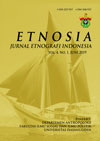Abstract
This article aims to analyze a series of Petik Laut traditions that are the background for the emergence of the Mursada song text. Culture that is continuously carried out will form a tradition. One of the traditions found in Indonesia is the tradition of Petik Laut carried out in Muncar. Another term for the sea quotation is charity marine coastal communities. In its implementation, the Petik Laut tradition has several series of events that must be carried out. The series of events became the background for the emergence of the Mursadasong text that was read when one day before the core event was held. This research is a qualitative descriptive study. The main data source is a series of Petik Laut traditions and tembang macapat texts. The provision of data is obtained by observation-participation techniques, interviews, and document analysis. The data were analyzed using linguistic anthropological theory to find out how the context of the tradition of seas was based on the emergence of the text of the Mursadasong in the Muncar fishing community. The results showed that the context of the sea-picking tradition behind the emergence of the text of the Mursadasong was the opening, the macapatan, the ider bumiand the release of offerings, and the pilgrimage of the grave.References
Ainiyah, N. (2017). “PETIK LAUT: Social-Ideological Accommodation in the Fishermen Community of Kedungrejo Muncar Banyuwangi”. Religia: E-Journal IAIN Pekalongan. Vol. 2. No. 2. Hal. 145-159.
Anoegrajekti, dkk. (2018). “The Oral Tradition of Petik Laut Banyuwangi Revitalization of Tradition and Local-Global Political Space”. ISLLE 2017. The 1st International Seminar on Language, Literature and Education, KnE Social Sciences. Hal. 595- 602 DOI 10.18502/kss.v3i9.2723.
Ekowati, V.I. (2006). “Warna Islam Dalam Teks Klasik Layang Mursada Pesisiran”. Jurnal DIKSI (Jurnal Ilmiah Bahasa, Sastra, dan Pengajarannya). Universitas Negeri Yogyakarta. Vol. 13. No. 1. Hal 22-31
Duranti, A. (1997). Linguistic Anthropology. United Kingdom: Cambridge. University Press.
Endraswara, S. (2005). Tradisi Lisan Jawa: Warisan Abadi Budaya Leluhur. Yogyakarta: Pustaka Widyatama.
Foley, W.A. (1997). Anthrpological Linguistics: An Introduction. Foreign Language and Teaching Press. Blackwall Published Ltd.
Hymes, D. (1974). Foundation In Sociolinguistics: An Ethnographic Approach. Piladelphia: University of Pennysvania Press.
Kridalaksana, H. (1984). Kamus Linguistik. Jakarta: Gramedia.
Moleong, L.J. (2010). Metode Penelitian Kualitatif. Bandung: Remaja Rodakarya.
Muanayah, N.A. (2012). “Tradisi Suran Masyarakat Traji (Suatu Kajian Antropologi Linguistik)”. Tesis. E-print UNDIP.
Oktavianus. (2006). “Nilai Budaya dalam Ungkapan Minangkabau: Sebuah Kajian dari Perspektif Antropologi Linguistik”. Linguistik Indonesia, Tahun ke 24, No. 1, Februari 2006.
Pateda. (2010). Semantik Leksikal. Jakarta: Rineka Cipta.
Sampson, G. (1980). “The Sapir-Whorf Hypothesis,” bab 4 dari Schools of Linguistics. Stanford: Stanford University Press.
Susilo, J. (2011). Serat Mursada: Suntingan Teks Disertai Telaah Falsafah Jawa. Skripsi. Universitas Airlangga. E-print Unair. http://repository.unair.ac.id/id/eprint/27778.
Susilo, J. (2014). Santri Lelana Pada Serat Mursada. Tesis. Universitas Airlangga. E-print UNAIR. http://repository.unair.ac.id/id/eprint/39016.
Winarti, D. (2016). “Tembang Dolanan Dalam Maasyarakat Jawa (Kajian Linguistik Antropologis)”. Disertasi UGM.
Wierzbicka, A. (1992). Semantics, Culture, And Cognition. Oxford: Oxford University Press.
Wulandari, W. (2013). “Mitos Dalam Upacara Petik Laut Masyarakat Madura di Muncar Banyuwangi: Kajian Etnografi”. Skripsi. Universitas Jember.
Yule, G. (1996). Pragmatik. Yogyakarta: Pustaka Belajar.
Yunitasari, H. (2017). “Mitos upacara Petik laut Masyarakat Etnis Madura di Desa Tambakrejo Muncar, Banyuwangi”. Skripsi. mulok.library.um.ac.id.





